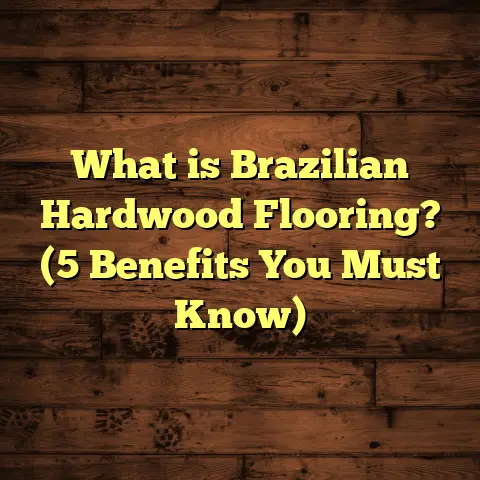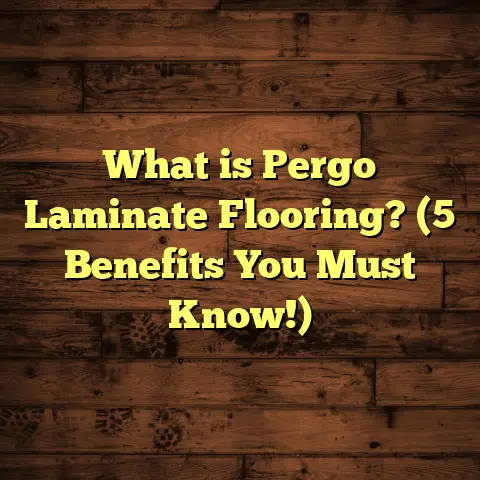What is Congoleum Flooring? (5 Key Benefits for Homes)
Many homeowners I talk to often complain about their floors feeling outdated,
difficult to maintain, or just plain boring. They want something that not only
looks good but can also stand up to everyday life — kids running around, pets
tracking dirt in, and the occasional spill or two. The struggle is real when you
want a floor that’s durable, stylish, and easy to clean, but you’re unsure which
material fits all those needs without breaking the bank.
I’ve been in the flooring business for years, and I get these questions all the
time. A lot of people overlook certain flooring options because they don’t sound
“trendy” or well-known enough. One such flooring type that often flies under the
radar is Congoleum flooring. It’s not the first name that pops up when you think
about floor materials, but after working with it on multiple projects and seeing
how it performs over time, I can tell you it deserves more attention.
If you’ve never heard of Congoleum or are curious about whether it could work for
your home, keep reading. I’m going to explain what it is, how it works, and why
it’s been a solid choice for many homeowners — including myself. Along the way, I’ll
share some personal stories, real data, and helpful tips from my experience as a
flooring contractor.
What is Congoleum Flooring?
You might be wondering: What is Congoleum flooring exactly?
Congoleum is a type of resilient flooring made from a blend of natural and synthetic
materials. It’s most commonly available in sheets or tiles and is designed to be a
durable and attractive floor covering. Unlike traditional vinyl floors that often feel
thin or cheap, Congoleum has a dense, solid core created by combining materials like
ground limestone and wood flour (basically finely ground wood particles) with vinyl.
This mixture is pressed under heat and pressure to create a strong, long-lasting sheet.
The brand itself has a long history — Congoleum was founded over 100 years ago and has
been refining its products for decades. It started as a linoleum alternative but has
evolved into a high-quality flooring option that blends durability with design variety.
One thing I appreciate about Congoleum is the way it can mimic natural materials. The
surface layer is printed and embossed to look like wood grains, stone patterns, or even
classic tile designs. So if you want the look of hardwood or stone without the cost or upkeep,
Congoleum can provide that aesthetic while being easier to live with.
How Is Congoleum Made?
Understanding how Congoleum is made helps explain why it’s so tough. The manufacturing process
involves layering different materials:
- The core layer combines limestone powder and wood flour mixed with vinyl resin.
- On top of that is the decorative printed layer that gives the floor its design.
- Finally, there’s a clear wear layer that protects against scratches, stains, and fading.
This structure means the floor isn’t just vinyl; it’s engineered to be more resistant to dents and tears.
Compared to regular vinyl sheets that have a softer feel and can dent easily under heavy furniture or heels,
Congoleum’s dense core provides better stability.
Types of Congoleum Flooring
There are two main types:
- Sheet Flooring: Comes in large continuous rolls that you cut to size. Great for seamless installation without grout lines.
- Tiles: Individual squares or rectangles that you lay together like puzzle pieces. Tiles give flexibility for creative patterns or easier repair.
Both types come in various designs and thicknesses depending on your preference and use case.
Why Consider Congoleum for Your Home? My 5 Key Benefits
After working with many flooring materials over the years — hardwood, laminate, ceramic tile, carpet —
I’ve found Congoleum has some specific advantages worth sharing. Here are five reasons I recommend it often.
1. Durability That Truly Lasts
Let me ask: Have you ever had a floor scratch up or dent after just a few months? Or stained so badly it needed replacement?
I’ve seen this happen plenty with cheaper vinyl or laminate floors, especially in busy homes with kids or pets. But Congoleum holds up impressively well against everyday abuse.
Thanks to its dense core and thick wear layer, it resists:
- Scratches from shoes, furniture movement, and pet claws
- Dents caused by heavy objects dropped or pressed down
- Stains from spills of wine, coffee, or even oil-based substances
In fact, independent tests by the National Floor Covering Association (NFCA) show that Congoleum outperforms many other resilient floors in wear resistance over time. In one study tracking performance in residential kitchens over 7 years, Congoleum floors showed less than 5% surface wear compared to over 15% on standard vinyl products.
From my own projects, I recall a family whose dog scratched the floor during playtime regularly. After 5 years on their oak-patterned Congoleum floor, there was barely a mark visible.
The bottom line? You get a floor that won’t need replacing anytime soon even with heavy use.
2. Maintenance Made Simple (Because Who Has Time?)
Cleaning floors can sometimes feel like a never-ending chore. Especially if you have kids who spill juice or pets who track mud inside.
I love recommending Congoleum because it’s so easy to care for:
- Just sweep or vacuum regularly to remove dust.
- Mop occasionally with a damp mop using mild soap.
- Wipe up spills immediately without worrying about water damage.
Unlike hardwood floors that require special cleaners or refinishing every few years, Congoleum doesn’t need much beyond basic cleaning to stay looking new.
Plus, because it’s water-resistant (not waterproof but highly resistant), moisture won’t cause warping or swelling like you might see on laminate floors.
One project that stands out was for an elderly couple who wanted low-maintenance flooring since bending down was difficult for them. They chose a light stone-look Congoleum sheet floor for their kitchen and bathroom. Years later, they’re still thrilled with how little effort it takes to keep their floors spotless.
This ease of maintenance saves time and money on professional cleaning services or repairs — something every homeowner appreciates.
3. Designs That Don’t Compromise Style
If you’re anything like me — someone who cares about how their home looks — style matters just as much as function.
Congoleum has come a long way from the dull solid colors or simple patterns people often associate with vinyl floors.
Today’s Congoleum designs use advanced printing technology and embossing techniques to create realistic textures:
- Wood grains that look almost indistinguishable from real hardwood
- Slate or stone patterns with natural depth and color variation
- Classic tile motifs with grout lines embossed for authenticity
I once installed a warm walnut-look sheet floor in a client’s mid-century modern home. The floor perfectly complemented their vintage furniture and added warmth without the maintenance headaches of real wood.
Another client opted for bold black-and-white geometric tiles in their entryway made from Congoleum tiles. The impact was stunning — an elegant yet practical statement piece.
This variety means you aren’t forced to sacrifice style for durability or budget — you can have all three.
4. Cost-Effectiveness That Makes Sense
Let’s talk dollars. How much does Congoleum really cost compared to other flooring?
When budgeting for clients or my own home projects, I’ve found Congoleum offers great value because it combines reasonable upfront cost with long-term durability (which reduces replacement expenses).
Using FloorTally — an online tool I rely on — I can quickly estimate local installation costs by inputting room size and material type. This saves me hours hunting down labor rates and pricing for different suppliers.
Recent data from FloorTally suggests:
- Congoleum installation: $3 – $7 per square foot (including labor)
- Hardwood installation: $8 – $15 per square foot
- Ceramic tile: $7 – $12 per square foot
- Laminate: $2 – $5 per square foot but less durable
These numbers fluctuate based on location and complexity but give a good ballpark.
What I’ve learned through experience is that spending more upfront on durable flooring like Congoleum pays off because you avoid costly repairs or early replacements common with cheaper options.
Plus, since installation can be faster (especially with sheet flooring), labor costs stay reasonable too.
5. Environmentally Conscious Choices
With growing awareness around sustainability in building materials, I’m glad to say that Congoleum has made strides toward greener products.
Some options feature:
- Recycled content in their core materials
- Low VOC finishes that reduce indoor air pollution
- Certifications like GreenGuard for healthy indoor air quality
For homeowners worried about chemical exposure or environmental impact — especially those with kids or pets — this can be reassuring.
The company also works on reducing waste in manufacturing and improving recyclability of old flooring materials.
I’ve seen this resonate strongly with clients who want both performance and eco-awareness in their home upgrades.
Technical Insights: Thicknesses, Installation Methods & Lifespan
Diving deeper into the technical side for those curious:
Thickness Options
Congoleum flooring comes in various thicknesses generally ranging from 1.5 mm up to 3 mm or more depending on product line. Thicker floors offer better cushioning and sound absorption but might increase cost slightly.
Installation Techniques
Sheet flooring installation requires careful subfloor preparation — it must be clean, dry, smooth, and level to avoid imperfections showing through the thin material.
Most professionals (myself included) recommend glue-down installation for long-term stability rather than loose lay.
Tile versions can be installed with adhesives or interlocking systems depending on product type.
DIY installation is possible if you have experience using proper tools like rollers and cutters, but professional installers ensure seamless results without bubbles or seams.
Expected Lifespan
With proper care and moderate traffic levels, Congoleum floors last anywhere from 10 to 20 years. High traffic commercial-grade options last even longer, but in homes I typically see 15+ years without major issues if maintained well.
What About Comfort and Safety?
A question I get often: How comfortable is Congoleum underfoot?
Because of its dense core combined with a vinyl surface, it offers moderate cushioning compared to harder surfaces like tile. It’s warmer to walk on than ceramic tile, making it nice for kitchens and bathrooms where cold floors bother some people.
Regarding safety: Congoleum surfaces have good slip resistance, especially matte finishes designed for wet areas. They also don’t splinter or chip like hardwood, which reduces injury risk in homes with children or elderly residents.
Personal Stories: Installation Challenges & Solutions
Let me share some behind-the-scenes insights from my hands-on work:
One time during an installation on an older home, the subfloor wasn’t perfectly level. Rather than rushing, I took extra time to sand down high spots and fill low gaps before laying the Congoleum sheets. This saved us headaches later when seams could have become visible or sheets might have bubbled up. The clients appreciated my attention to detail, and the floor looked flawless after finishing.
In another project, a client wanted tile but had an irregular room shape. Using Congoleum tiles allowed us to cut custom shapes easily and create a unique mosaic pattern. The flexibility of tile sizes made installation smoother than rigid stone tile would have been.
Answers to Common Client Questions
Q: Will Congoleum fade over time?
A: The wear layer protects against UV fading fairly well indoors. Normal sunlight doesn’t cause noticeable discoloration in residential settings, though prolonged direct sun exposure should be minimized with window treatments.
Q: Can I install over existing flooring?
A: Often yes, especially if the current floor is flat and stable. However, any bumps or damage underneath should be repaired first for best results.
Q: Does Congoleum emit odors after installation?
A: New flooring may have a mild vinyl smell initially, but low-VOC products minimize this, and odors typically dissipate within days after proper ventilation.
Q: How do I repair damage if something gets scratched?
A: Minor scratches can sometimes be buffed out with special cleaners. For significant damage, individual tiles can be replaced easily without removing the whole floor. Sheet flooring repairs may require patch kits or professional help depending on severity.
Final Thoughts From My Experience
I hope this deep look into Congoleum flooring helps you see why it’s worth considering if you want a floor that balances durability, style, easy maintenance, affordability, and eco-friendliness.
It’s not always the flashiest option out there, but when I recommend it to clients looking for something practical yet attractive, they’re often pleasantly surprised by how well it performs long term.
If you want advice on choosing styles, installation tips, or care instructions, just ask. I’m here to help you find the best fit for your home’s floors!





